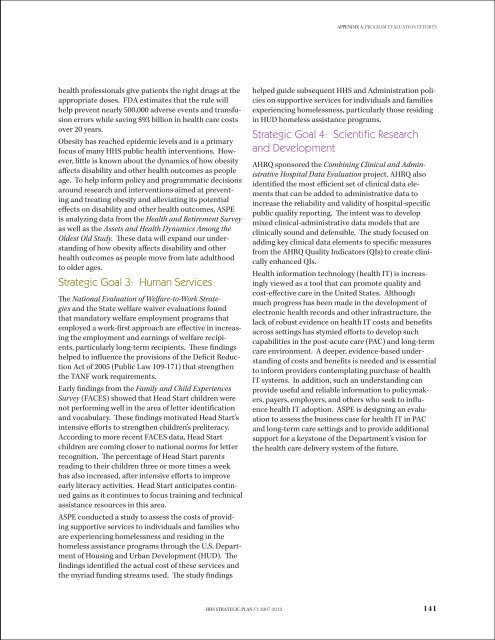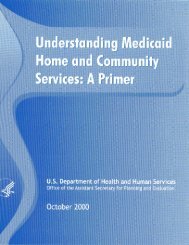STRATEGIC PLAN - ASPE - U.S. Department of Health and Human ...
STRATEGIC PLAN - ASPE - U.S. Department of Health and Human ...
STRATEGIC PLAN - ASPE - U.S. Department of Health and Human ...
Create successful ePaper yourself
Turn your PDF publications into a flip-book with our unique Google optimized e-Paper software.
Appendix a: program evaluation effortshealth pr<strong>of</strong>essionals give patients the right drugs at theappropriate doses. FDA estimates that the rule willhelp prevent nearly 500,000 adverse events <strong>and</strong> transfusionerrors while saving $93 billion in health care costsover 20 years.Obesity has reached epidemic levels <strong>and</strong> is a primaryfocus <strong>of</strong> many HHS public health interventions. However,little is known about the dynamics <strong>of</strong> how obesityaffects disability <strong>and</strong> other health outcomes as peopleage. To help inform policy <strong>and</strong> programmatic decisionsaround research <strong>and</strong> interventions aimed at preventing<strong>and</strong> treating obesity <strong>and</strong> alleviating its potentialeffects on disability <strong>and</strong> other health outcomes, <strong>ASPE</strong>is analyzing data from the <strong>Health</strong> <strong>and</strong> Retirement Surveyas well as the Assets <strong>and</strong> <strong>Health</strong> Dynamics Among theOldest Old Study. These data will exp<strong>and</strong> our underst<strong>and</strong>ing<strong>of</strong> how obesity affects disability <strong>and</strong> otherhealth outcomes as people move from late adulthoodto older ages.Strategic Goal 3: <strong>Human</strong> ServicesThe National Evaluation <strong>of</strong> Welfare-to-Work Strategies<strong>and</strong> the State welfare waiver evaluations foundthat m<strong>and</strong>atory welfare employment programs thatemployed a work-first approach are effective in increasingthe employment <strong>and</strong> earnings <strong>of</strong> welfare recipients,particularly long-term recipients. These findingshelped to influence the provisions <strong>of</strong> the Deficit ReductionAct <strong>of</strong> 2005 (Public Law 109-171) that strengthenthe TANF work requirements.Early findings from the Family <strong>and</strong> Child ExperiencesSurvey (FACES) showed that Head Start children werenot performing well in the area <strong>of</strong> letter identification<strong>and</strong> vocabulary. These findings motivated Head Start’sintensive efforts to strengthen children’s preliteracy.According to more recent FACES data, Head Startchildren are coming closer to national norms for letterrecognition. The percentage <strong>of</strong> Head Start parentsreading to their children three or more times a weekhas also increased, after intensive efforts to improveearly literacy activities. Head Start anticipates continuedgains as it continues to focus training <strong>and</strong> technicalassistance resources in this area.<strong>ASPE</strong> conducted a study to assess the costs <strong>of</strong> providingsupportive services to individuals <strong>and</strong> families whoare experiencing homelessness <strong>and</strong> residing in thehomeless assistance programs through the U.S. <strong>Department</strong><strong>of</strong> Housing <strong>and</strong> Urban Development (HUD). Thefindings identified the actual cost <strong>of</strong> these services <strong>and</strong>the myriad funding streams used. The study findingshelped guide subsequent HHS <strong>and</strong> Administration policieson supportive services for individuals <strong>and</strong> familiesexperiencing homelessness, particularly those residingin HUD homeless assistance programs.Strategic Goal 4: Scientific Research<strong>and</strong> DevelopmentAHRQ sponsored the Combining Clinical <strong>and</strong> AdministrativeHospital Data Evaluation project. AHRQ alsoidentified the most efficient set <strong>of</strong> clinical data elementsthat can be added to administrative data toincrease the reliability <strong>and</strong> validity <strong>of</strong> hospital-specificpublic quality reporting. The intent was to developmixed clinical-administrative data models that areclinically sound <strong>and</strong> defensible. The study focused onadding key clinical data elements to specific measuresfrom the AHRQ Quality Indicators (QIs) to create clinicallyenhanced QIs.<strong>Health</strong> information technology (health IT) is increasinglyviewed as a tool that can promote quality <strong>and</strong>cost-effective care in the United States. Althoughmuch progress has been made in the development <strong>of</strong>electronic health records <strong>and</strong> other infrastructure, thelack <strong>of</strong> robust evidence on health IT costs <strong>and</strong> benefitsacross settings has stymied efforts to develop suchcapabilities in the post-acute care (PAC) <strong>and</strong> long-termcare environment. A deeper, evidence-based underst<strong>and</strong>ing<strong>of</strong> costs <strong>and</strong> benefits is needed <strong>and</strong> is essentialto inform providers contemplating purchase <strong>of</strong> healthIT systems. In addition, such an underst<strong>and</strong>ing canprovide useful <strong>and</strong> reliable information to policymakers,payers, employers, <strong>and</strong> others who seek to influencehealth IT adoption. <strong>ASPE</strong> is designing an evaluationto assess the business case for health IT in PAC<strong>and</strong> long-term care settings <strong>and</strong> to provide additionalsupport for a keystone <strong>of</strong> the <strong>Department</strong>’s vision forthe health care delivery system <strong>of</strong> the future.HHS Strategic Plan FY 2007-2012141
















